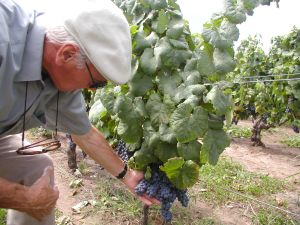Daily News Links
October 25, 2006
Back in July 2001, Wine Business Monthly reported on the budding wine export scene in Uruguay. A new consortium of wine exporters, newly created powers for the quasi-government agency INAVI, and general interest in what was happening in South America all gave Uruguay a shot at being the new niche player on the block.
Then the economic collapse of 2001 hit the southern part of the continent and virtually everything got shoved to the back burner while wineries scrambled just to survive. Smartly, the consortium and INAVI quickly began a marketing push that expanded beyond their former largest markets of Argentina and Brasil – focusing on Europe and the United States. At the same time, outside investors continued to put their faith and capital into the technological development of Uruguayan wineries.
Uruguay can now boast some of the most technologically advanced wineries in South America, with computer controlled fermentation systems. Still, they’re limited in volume of production by the mere size of the country – smaller than the state of Washington – and a domestic demand for inexpensive table wine.

Señor Abbona, the “maestro de las cavas”, or cellar-master checks the Tannat grapes at Cerros de San Juan
The quality of the fine wines has steadily improved with time. Good as they were five years ago, of the thirty some producers who are producing export quality wines, there are now half a dozen who are producing wines that could arguably be called “world class.”
Tannat is the dominating factor in that equation – Uruguay will probably never be able to compete against the vast numbers of Cabernets, Merlots, and Chardonnays that are on the market, but Tannat gives them a weapon that borders on unique. The style of Uruguayan Tannat is different from that of the small production of wine in Madiran in France – focused on fruit, spice, and food friendliness rather than structure and long term aging. That very fact led the Madiran producers’ consortium to cancel a “taste-off” last year – the drinkability of Uruguayan Tannat at a much younger age gave rise to concerns about a repeat of the infamous 1976 France versus California battle.
The biggest problem Uruguay faces in the international market remains the same as it was five years ago. No one knows where Uruguay is, let alone anything about it. The wines remain a hand-sell for any importer or distributor willing to take on a line – in general a large distributor won’t take them on for fear of them being lost amongst their other offerings, and a small distributor knows there’s a huge amount of work in relation to the investment of capital. Given that, one of the more exciting developments has been the partnership between Boisset America and the Pisano winery, producing a separately raised, fermented, and bottled line under the Viña Progreso label, backed by the marketing arm of Boisset. At the same time, producers like Juanicó have further developed their partnership with the Bernard Magrez , multimillionaire owner of nearly three dozen wineries in Bordeaux, Priorat, and Napa Valley, including the top flight Château Pape-Clement, and are now in the process of building a separate winery specifically for the production of their garagiste style Tannat, “1er Cru Garage”. Pizzorno is in the process of building a state-of-the-art underground, gravity fed winery. Up-and-comer Bouza has invested in one of the most technologically advanced wineries I’ve seen – giving a feel of being on the set of Star Trek, yet maintaining a complete family involvement, and hands-on winemaking approach. New tasting rooms are being added to virtually every winery that produces quality wine, specifically to entice locals and tourists to sample their new wares.
It is hard to judge whether there is a stigma attached to wines coming from an unknown region or not. The Association of Exporters of Wines has held Tannat tastings in the United States for the last two years with limited results. Getting top sommeliers and retail buyers to attend a tasting devoted to something obscure is always a challenge, yet those are the very people who will create the demand for something new. Invitations to multiple wine writers for an all expenses paid tour of a dozen Uruguayan wineries this year resulted in interest from only two, and due to time constraints, only one, myself, was able to take advantage of the offer.Boutique winery Viñedos de los Vientos, the sole producer in the southeastern area near Atlantida, experimented with submitting two bottles of one of their wines to a well known consumer wine magazine – one directly from the winery with its normal label, the other with essentially a mystery label, but presented to the reviewer by an importer as “something he must try.” The two bottles were tasted in the same flight and resulted in completely different descriptions as to profile and quality, and markedly different scores – the Uruguayan labeled one coming in well behind the other.
Still, INAVI, the consortium, and the individual producers have lost neither hope nor enthusiasm. They know they’ve got a product worthy of attention, and they’re not only putting their money where their mouths are, but investing their lives into getting Uruguay onto the maps of the wine cognoscenti. A more ambitious schedule of tastings in the United States is already underway for 2006-2007; nearly non-existent advertising budgets are being expanded to entice consumer and professional magazines to pay more attention; and the quality of wines just keeps getting better and better. With all that in play, Uruguay truly is “ready” to play their part in the global game of wine.
